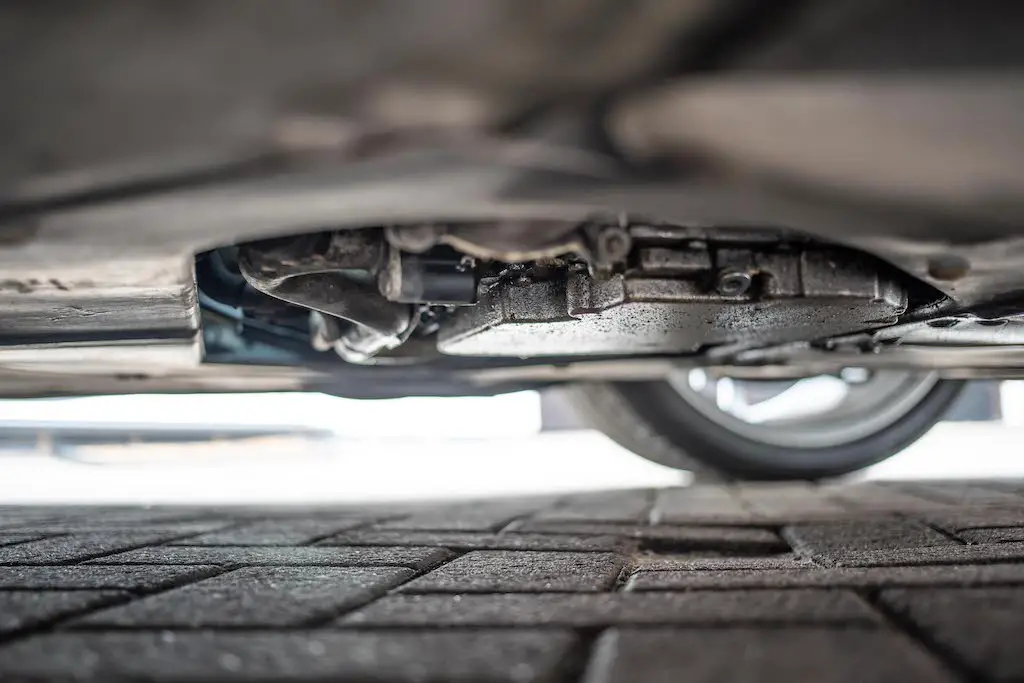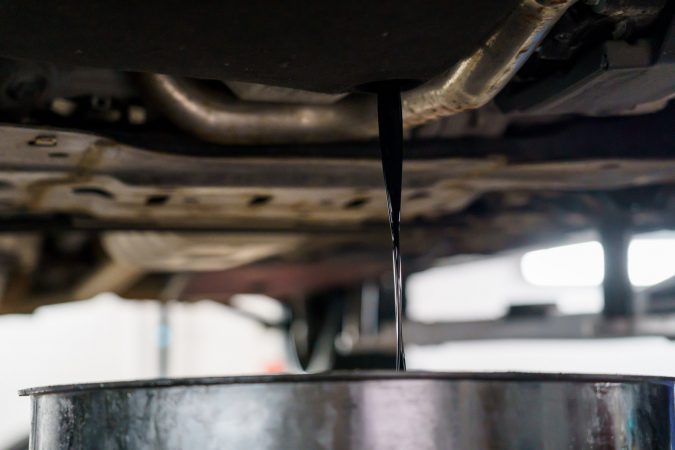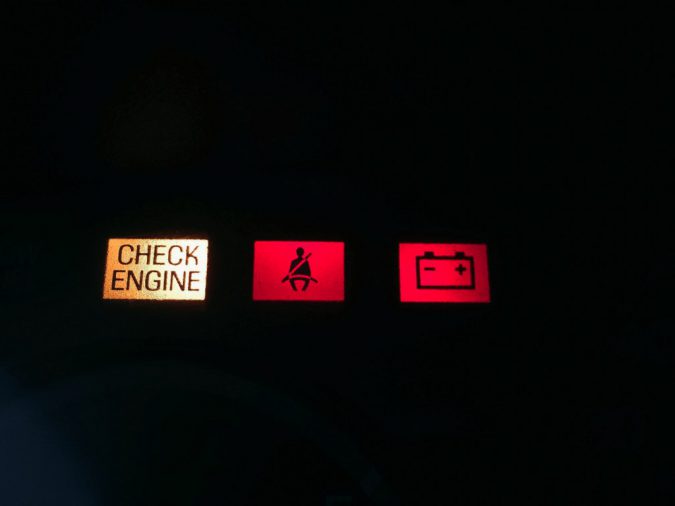The humble transmission is one of the most important components in any vehicle. As pivotal as it is for the engine to produce power, it’s just as – if not more – crucial for that power to be controlled and applied carefully to the tires. This is where our friend, the transmission comes in. Given its significant role in making a car move, it’s no wonder that even the most simple failures could be headache-inducing. Transmission cooling lines leaking is just one of the many potential problems.
It is no doubt heart-breaking to walk up to your car and see a shiny, oily puddle underneath it. But before you worry too much, cooler lines are thankfully one of the less serious woes you might expect to face. So, your wallet can rest a bit easier now knowing this. For that reason, transmission cooling lines leaking should be addressed as soon as possible. Or else, you could face much costlier repair bills in the near future. Our guide here should hopefully give you some pointers.
Transmission Cooler Lines
Before we get into discussing transmission cooling lines leaking, we should discuss more about what that particular part does in your car. So, what are transmission cooling lines, and what do they do? To answer that, we’ll need to have a peek at your gearbox’s transmission fluid. Transmission fluid is key in making sure your car’s gearbox doesn’t wear out quickly. Just like the engine oil, transmission fluid works to lubricate the many parts working inside your car’s transmission.
Furthermore, it also doubles as the coolant for the gearbox. All those many moving parts mean that there’s bound to be a lot of friction, and thus heat emitted within the transmission itself. It’s the fluid’s job to keep that in check. In fact, many technicians and mechanics can agree that overheating is the No. 1 cause of transmission failure in most cars. This could either be due to a car running on worn or burnt out – and thus ineffective – transmission fluid.
Or, it might be due to the fact the transmission’s cooling system has gone awry. Generally, there is a very simple chart agreed upon that directly correlates how heat can result in transmission failure. This is a comparison between the operating temperature of the transmission, and how many miles it can go before it fails completely.
- 325 °F – ~500 miles
- 300 °F – ~2000 miles
- 275 °F – ~15,000 miles
- 250 °F – ~30,000 miles
- 225 °F – ~60,000 miles
- 200 °F – ~90,000 miles
- 175 °F – ~100,000+ miles
How Do Transmission Coolers Work
We can say that generally speaking, a car’s transmission works best at around 175 °F to 200 °F. This is the optimal operating temperature to ensure that the transmission can work best and reliably. Constantly running your gearbox at temperatures above 300 °F or higher could easily kill your transmission within just a couple of thousand miles. Not good, then. This is why transmission cooling lines leaking can be such a major problem. Put it off for too long, and it can overheat.
But what does the cooling line do, exactly? Quite simply, the cooling lines are two sets of rubber (sometimes metal) tubing. One of them carries hot transmission fluids out of the transmission, and the other feeds cool fluids back into the gearbox. When it’s running, there is a pump inside of the transmission that circulates the flow of transmission fluid. This pump will then start moving the hot fluids which have been circulating within the transmission to one cooling line.
The “hot” cooling line is connected to your car’s radiator. From here, it will gradually be cooled down. This will flow back through another, “cool” cooling line. It then feeds the colder transmission fluid back into the gearbox. The looping process ensures that the temperature of the transmission fluid, and thus the entire gearbox, is kept in its most optimal range. It’s for this reason why transmission cooling lines leaking usually appear at the front of your car, near the radiator.
Transmission Cooler Types
Although it may seem like a very simple component, there are actually different types of cooling lines. These varying shapes and forms will ultimately determine the cause of the transmission cooling lines leaking. Not to mention, it will impact the final cost of repairing it. Either way, these cooling lines are then connected to both the radiator and the transmission through a number of clamps, seals, and fittings. These too could be plausible points of failure to consider.
We can distinguish the many different sorts of cooling lines based on the material that they’re made of. It’s also going to be important for you to know how these cooling lines are being connected to the radiator and transmission. For rubber tubing, it will suffice to use simple hose clamps. They’re cheap and can sustain a lot of vibrations from the car. Though, they may not be durable enough to handle the high pressures of fluids that the cooling lines need to carry.
If you’re using metal or reinforced cooling lines, they too will have their respective fittings. These can be metal clips or barb-style fittings. Some are stronger than others but will come at higher costs. As for the type of cooling lines, you’re most likely to encounter four unique types;
1. Rubber
This is the most common material to be used as transmission cooling lines. It’s also the cheapest and one that you’ll find most as third-party repairs. There is at least one significant downside to using rubber cooling lines. The rubber compound is constantly exposed to intense amounts of heat from the hot transmission fluid or engine components. Consequently, they can harden and crack over time, forming a leak. They are, at least, inexpensive to replace.
2. Metal
These metal tubings are often bent and shaped to fit around your transmission and other parts on the way towards the radiator. They have fittings pre-done which helps to hold the metal tubes in place. Most cars would often come with metal cooling lines straight from the factory. The key failing for these metal tubes is corrosion. Exposed to elements, it can rust over time, which will inevitably result in damage or a hole. These can be a bit more costly to replace.
3. Nylon Braided
A step up from simple rubber tubing, some manufacturers choose to use nylon braids. Practically shielding the outer layer of the rubber lines, the nylon protects the tubes from external damage. This includes any debris or heat from the engine bay that may cause wear and tear on the cooling lines. Overall, nylon braided cooling lines are more durable. However, they are also more costly whenever replacements are needed and are still subject to the degradation of rubber internally.
4. Steel Braided
An even bigger upgrade from nylon, you can get some transmission cooling lines with steel braiding. Ultimately, it’s still a rubber tube that runs underneath the steel protective layers. That said, this is significantly more durable than nylon, and especially so compared to bare rubber. Steel braided cooling lines are often found in higher-performance or heavy-duty vehicles. Unfortunately, there is a significantly bigger price tag attached to these cooling lines than their less hardy brethren.
Transmission Fluid Leak Symptoms
Now, this might sound like a rather silly topic to discuss. Of course, the most tell-tale symptom of transmission cooling lines leaking is the greasy puddle that we mentioned earlier. Leak… Puddle of fluids… It all makes sense! However, there are times when it can be difficult to notice that your car’s gearbox fluids are leaking. What if it leaks while you’re driving, and you’ve practically dried it out by the time you had a chance to stop? What if it’s nighttime, and you can’t see very well?
Or, what if there’s been raining cats and dogs, and it’s washed down all your leaky transmission fluid down the drain? Understanding these circumstances, we can see that it’s important to be more attentive to the potential for other symptoms cropping up other than visual cues. So, how and when can you take notice if your car is experiencing transmission cooling lines leaking?
Transmission Cooling Lines Leaking Symptoms #1: Reddish Pool Of Fluid Underneath Your Car
Let’s get the obvious out of the way first, shall we? It should be worthwhile to know that there are a lot of other fluids running inside of your car. Therefore, you ought to try and understand the different colors of these liquids. In the case of transmission fluid, it should be a reddish color. If it’s a bit more worn and burnt out since the last time you’ve had it replaced, then it should be more maroon or reddish brown color. Now, see if there’s such a puddle near the front.
As we highlighted earlier, the transmission cooling lines leaking should appear close to the radiator. If you can’t find a more distinct puddle, try popping open the hood or getting under your car. See if you can spot any of that red or reddish brown transmission fluids on any of the tubing or hoses. One tip that we can give you is to bring along a white paper towel or plain piece of paper. Wipe this down on any liquids you might see, and it’ll give you a clearer indication of the color.
Transmission Cooling Lines Leaking Symptoms #2: Low Transmission Fluid Level
Naturally, if there’s a leak, then there should be a subsequent drop in the volume of said transmission fluid. This is another easy way of seeing if it’s indeed your transmission cooling lines leaking. Some cars might notify you of low levels of transmission fluid through a warning on the instrument cluster, such as a ‘check engine‘ light. Otherwise, you could try to find the transmission fluid reservoir, and check the dipstick to make sure you have enough.
Transmission Cooling Lines Leaking Symptoms #3: Burning Smell Or Overheating Gearbox
If you do have transmission cooling lines leaking, then this will ultimately result in your gearbox overheating. At the very least, it’ll start running a lot warmer than usual. It might be that you’ve leaked enough that there’s an insufficient volume of transmission fluids to cool down the gearbox. Or, the leak itself might seriously impede on your gearbox’s ability to cool itself, such as not being able to flow cool liquids back into the transmission.
One other potential fault is a clog in the cooling lines, which is resulting in a poor flow rate of transmission fluids. In any case, your car might warn you of this with an array of warnings on the dashboard. You could alternatively notice this through your nose. A particular ‘burnt’ or heaty smell can be felt, especially after driving your car for a while. This is a clear-cut method of telling if your car’s transmission – or any other component, like the engine – might be overheating.
Transmission Cooling Lines Leaking Symptoms #4: Visible Damage On The Cooling Lines
If you happen to get underneath your car, then try and inspect the transmission cooling lines themselves. Poke around (carefully) and have a flashlight handy to check the lines for any damage. You might be able to notice right away if there’s a hole. Alternatively, you can see if there are bulges, indents, or cracks on the tubing. Regardless of what material the transmission cooling lines are made from, they should be uniform and evenly shaped.
As we highlighted earlier, different types of transmission cooling lines will suffer from unique and varying degrees of damage. Most cars come with metal cooling lines from the factory. These can be subject to corrosion, and a leak ought to appear in no time. They are then replaced with rubber tubes. When exposed to heat for too long, these rubber tubes can harden and crack, which will weaken over time and spring a leak. Reinforced lines are hardier, but are still susceptible to damage.
Transmission Cooling Lines Leaking Symptoms #5: Odd Noises While Shifting Gears
A consequence of there being a leak means that there’s (a lot) less transmission fluid than what was otherwise required for the gearbox’s smooth operation. Hence, one symptom that you might experience in the event of transmission cooling lines leaking is odd noises while shifting gears. This will happen as your transmission isn’t being lubricated properly. You will be able to hear grinding, crunching, or squealing noises, especially just after you start it up or change into ‘park’.
Transmission Cooling Lines Leaking Symptoms #6: Difficulty Shifting Into Gear
If by some chance you’re not able to hear your transmission grinding along, you’ll certainly be able to feel it. The condition of the transmission fluid is detrimental to the performance of the gearbox. Remember, there are a lot of moving parts inside of a transmission that requires lubrication and cooling. Not enough, and the gearbox will make itself known. You might feel as though your car is shifting hard. The transmission may slip and miss out on gears.
You might feel as though the car is holding onto the gears, or if it’s reluctant to shift. This difficulty in shifting felt especially when you’re changing down, as well as slippage, is a clear sign that something’s amiss with the gearbox. We’ve found that most transmission repairs are caused mainly by poorly or ill-maintained transmission fluid. It’s important that you have this checked out promptly, as continually driving your car like this will possibly cause bigger problems down the line.
How Much To Fix Leaking Transmission
Now that we’ve understood what to look out for if you’re in the midst of transmission cooling lines leaking, it’s a good time to discuss how we can fix this. For the most part, problems with your car’s cooling lines are solvable only with a replacement. But this isn’t always the case, as the leak may not come from the cooling lines themselves. It may be due to a poor or faulty connector, which connects the lines to the transmission and radiator, respectively.
Or, it might be a seal that has worn out. In this case, you could try to patch up the connectors with some specialized sealant. But you should be wary to consider using a sealant that is designed for high heat applications. You could also use strong tape, like Teflon. You could wrap it around the leak to keep it sealed. This is by far a very cheap fix, with rolls of Teflon being not much more expensive than $5. However, sealing the leaks in this way only works well temporarily.
You should only resort to using this if you really have no other choice. For instance, if you need to patch it up for an extra day to prepare for a trip down to the workshop. Another option is buying new connectors for your transmission cooling lines. Once again, this only works if the leaks are on either end, not the actual tubing itself. A good connector helps to create a better seal. You can find great options for less than $10, though you could also splash for higher quality ones upwards of $20.
Transmission Cooler Lines Replacement Cost
If worse comes to worst, and the leak is within the tubing itself, then you’re best off trying to replace the entire cooling line. Patching up the leaks, in this case, won’t be helpful, especially if you’re trying to prevent it from getting any worse. Thankfully, the raw materials for a transmission cooling line aren’t very expensive, relatively speaking. On sites such as AutoZone or Amazon, you could find high-quality cooling lines for as little as $15, and onwards to around $50.
There are even dedicated kits to aid you in repairing transmission cooling lines leaking. Although, we don’t recommend taking this route unless you know what you’re doing. Firstly, these repair kits are costly, with even the most basic kits starting out at $80, and it goes on beyond $200. While the repair kits themselves do host a huge number of extra bits and pieces in the package, such as rubber tubing, adapters, fittings, and so on, these are best designed for professionals.
If you’re keen to go the DIY route, it may prove far cheaper to buy the individual raw parts and put them together. The process of replacing the cooling lines is not the hardest in the scope of car maintenance. So, you could feasibly do this from home. Otherwise, it’s probably a lot easier if you’d just send your car down to a garage. As for the price, labor is the biggest contributor here while raw materials are peanuts in comparison. Expect a bill of around $100 to $500 for the full job.
Transmission Cooling Lines Leaking Facts:
- Transmission fluid is essential for a car’s good health as it lubricates the transmission components, activates gear changes, and releases heat from the system’s internal parts.
- The transmission coolant removes excess heat from the transmission fluid, and leaking transmission cooling lines can affect the performance of the entire transmission system.
- The transmission cooler lines perform two tasks: carrying the transmission fluid to and from the transmission and transporting the fluid back and forth to an external or radiator-integrated cooler.
- Symptoms of leaking transmission cooling lines include visible damage, hard shifting, and overheated transmission.
- A low level of transmission fluid caused by a leak can lead to an overheated and damaged transmission, so it’s crucial to address the problem promptly.
- Faulty transmission cooling lines can discharge a considerable amount of fluid quickly, resulting in possible transmission failure.
- The average cost of replacing transmission cooling lines can range between $100 and $400, depending on the car’s make and model, prices of parts, labor costs, and state taxes and fees.
- Transmission cooler lines are made of metal, rubber, or a combination of both, and they can wear out or deteriorate under various circumstances.
- Regular car maintenance includes inspecting under the hood and checking the cooler lines for any visible damage.
- The cost of repairing or replacing a transmission is significantly higher than the cost of repairing transmission cooling lines.
Conclusion On Transmission Cooling Lines Leaking
The cost for completely fixing transmission cooling lines leaking will vary depending on your car. While we could only give you a rough estimation, there are ways in which you could find a more precise quote. With sites like YourMechanic, Kelley Blue Book, RepairPal, Auto Repair Compare, WhoCanFixMyCar, Wrench, OpenBay, ClickMechanic, and more make this process seamless. All you need is your car’s registration number or make and model, and it’ll throw you a price.
In any case, even in the priciest scenario where you’re paying $500 or a bit more for a replacement, it still beats the cost of fixing or replacing your entire transmission. For that, you better prepare at least $1,000, sometimes higher than $3,500 depending on your car. Comparatively, the cost of replacing the cooling lines seems like a bargain. It’s for that reason why we’d highly recommend getting it checked out and fixed or replaced as soon as you spot something wrong.
It’s uncanny to learn how what might be a couple of rubber hoses could cost you so much damage if you keep ignoring them. As we learned so many times before in our other maintenance guides regarding the transmission, that reddish liquid is a very important piece of the puzzle. Never underestimate the effect that transmission fluid can have on your car. For this alone, we hope you’ll take transmission cooling lines leaking very seriously if it ever happens.
FAQs On Transmission Cooling Lines Leaking
If you’re still curious to learn more about transmission cooling lines leaking, our FAQs here might help…
How Long Does It Take To Fix A Transmission
Transmissions are among the most complex single components in any vehicle. Thus, fixing them can often take a long time. Even simple routine services like a transmission fluid change would already take you between 3 to 4 hours. Meanwhile, more extensive repairs could sometimes take several days or nearly a week. It all depends on what sort of work is needed to get it running again. A typical repair could take even an experienced mechanic 1 to 2 days to sort out. On the other hand, an in-depth rebuild process will take you far longer, usually between 3 to 4 days or more. Speaking of, replacing a transmission cooler line is relatively quick, which could be done in around 1 to 2 hours. However, if more repairs are needed, you can expect to leave your car at the workshop for a whole day or more.
What Causes Transmission Fluid To Leak
Transmissions are mostly enclosed units, so seeing any transmission fluid leaks is a bad sign of things to come. There are several reasons why your car’s transmission fluid is leaking. The most common point of failure is the transmission fluid pan or reservoir, and its accompanying drain plug. After some time, the gaskets and seals there would start to wear out and fail, causing gearbox oils to leak through. Having mentioned that, your gearbox also contains numerous other seals and gaskets, especially around the input and output shafts, as well as the transmission housing, valve body, shifter housing, torque converter, and driveshaft. These could also wear out and leak, too. Another source of transmission fluid leakage issue is around the transmission cooling lines, which feed into the transmission cooler.
What Color Is Transmission Fluid Leak
If you’re seeing a puddle underneath your car, you can often tell what fluids are leaking based on their color. In the event of a transmission fluid leak, you should notice a reddish-brown fluid. Moreover, it has a relatively thin viscosity when it’s new. However, it’s easy to confuse transmission fluid for power steering fluid, as the latter is a reddish-brown fluid, too. One way to clearly discern between either one is to see where the fluid leakage is generally coming from. If it’s trickling from closer to the front of the vehicle, then you’re looking at power steering fluid. Although, if the leak is coming from closer to the middle of your car, then that should be transmission fluid.
How Long Can A Car Run Without Transmission Fluid
Just like what motor oil is to the engine, transmission fluid plays a key role in maintaining your car’s gearbox. Mainly, it provides lubrication between the many moving parts inside of a transmission, thus preventing them from grinding and wearing each other out. Plus, the transmission fluid also functions as a coolant, by both reducing the friction between the transmission’s moving parts, as well as taking heat away from hot components. Therefore, driving without any transmission fluid is a terrible idea. Yet, it’s still feasible to drive without it. Some say that you could still for up to 10 or 15 miles without any transmission fluid. However, that too isn’t recommended, as you’re only inviting serious and terminal damage to occur within the transmission.
Do I Need A Transmission Cooler
One of the most common reasons why transmissions fail is due to overheating and high temperatures. This should be mitigated by the transmission fluid, although in some cars, this still isn’t enough to help cool the transmission. For the most part, the majority of regular, day-to-day commuter vehicles out there could run find without needing any special transmission coolers. However, the same can’t be said if you’re driving a heavy-duty truck or are typically towing and hauling a lot of stuff. Driving with a lot of load will put more strain on the transmission, thus raising its temperature more easily. The same goes for race cars or hardcore off-roaders. In these instances, installing a transmission cooler would certainly help to extend the service life of the transmission by keeping it cooled.




